Home-schooled, shy and intensely private, Aussie CASEY STONER wasn’t meant to be a motorcycle superstar, let alone a World Champion. Swept up in one of racing’s most intense rivalries, he remains MotoGP’s greatest-ever giant killer. We take a look at his illustrious career…
In 2007 Casey Stoner became Australia’s youngest-ever world grand prix champion aged 21. He secured 45 career grand prix victories across 125, 250 and MotoGP to sit second behind Mick Doohan’s record 54 wins. When you delve deeper into Stoner’s rivalry with nine-time world champion Valentino Rossi, he outscored the great Italian on every key measure from race wins and poles to fastest laps and podium finishes.
From 2006 to 2012 Stoner secured38 grand prix victories to Rossi’s 26, not forgetting Casey’s rookie year was winless aboard a satellite 990cc Honda RC211V. He also scored most of his wins–23–on the unwinnable Ducati, a bike Rossi failed to put on the top step in two years of trying. They each secured two MotoGP championships in the seven seasons they swapped paint. Across all key measures based on percentage of race starts, Casey finished 39 per cent ahead of Rossi. It is a stunning statistic that many Rossi fans will have trouble reconciling, but there it is in black and white. Mano a mano, Casey Stoner was by far the better performed rider of the two.
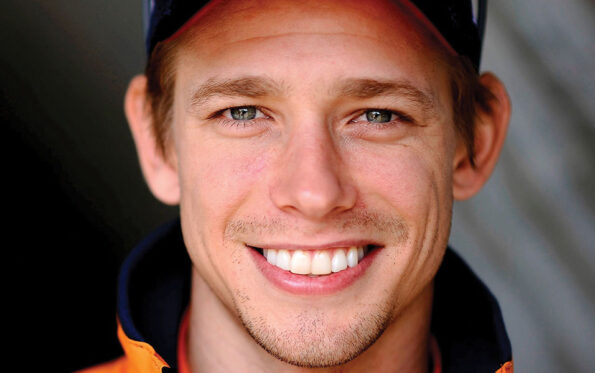
When Casey retired, veteran MotoGP correspondent Colin Young wrote what many were thinking: ‘In Stoner’s seven seasons in MotoGP he dismantled the myth that Valentino Rossi was an untouchable genius”. After Stoner won his maiden MotoGP championship in 2007, five-time 500cc world champ Mick Doohan made the point. ‘Casey’s gone head-to-head with Valentino Rossi, one of the greatest riders of all time, and come out on top, so there’s nothing lucky about it. To put it in context, what Casey has done would be like a 21-year-old Aussie kid beating Tiger Woods at golf or Roger Federer at tennis.’ Fire and ice, Stoner and Rossi were polar opposites. Rossi was the zany, global superstar wowing fans with his comedic post-race celebrations. Shy and introverted Stoner shunned publicity and just wanted to race. Their rivalry was unmatched, neither gave an inch.
Forever the iconoclast, Stoner initially followed the lead of other Aussie world champs by basing himself in Monaco but the shallowness of the seaside principality proved too much. ‘Monaco’s got no soul,’ Casey decried. ‘You have to be stupidly rich and if you’re not driving a Ferrari or Maserati, you’re nobody.’ He shifted gears to Geneva.
Casey Stoner was a project of his father Colin, an unheralded club racer. In 2012 when he announced his retirement, Casey said his parents had pushed him to race all his life. From the moment Casey first sat on a minibike around the time Wayne Gardner was battling for the 1987 world 500cc championship, Colin was preparing his son for the very same success. As Italian MotoGP journalist Enrico Borghi explained in 2012, ‘When Casey came to this paddock in 2002, he was very young. A lot of kids come to this sport like a boxer looking for revenge on life, they are hungry. Casey was typical of this.’
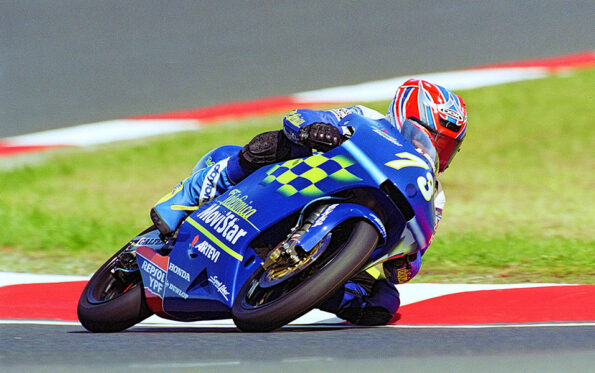
When kids learn to ride their Pee Wee 50 most dads are happy if they don’t crash. When Casey was able to demonstrate sufficient balance and throttle control, Colin spotted waisthigh spinifex and told Casey to ride into it to see how long he could stay in there without falling off.
With mum Bronwyn, Casey’s dad and his two sisters, the Stoners were for a time itinerant painters and decorators travelling around the countryside chasing the junior dirt-track circuit, a fiercely fought crucible of young Aussie talent dating back to Wayne Gardner’s early days. While some parents were spending $10,000 on trick barrels, carbies and power pipes for their brand-new mini rockets, Colin could only afford second-hand bikes. He worked hard to make them competitive but it schooled Casey on getting the most out of his slower machines, winning 40 national and 71 state titles if you don’t mind.
On one occasion Colin had a runin with race officials and was banned from the following event. Resourceful as ever, the Stoners set up their pit away from everyone else along the venue’s tall cyclone fencing. With Casey’s bike leaning against the fence, Colin fettled the bike through the outer side of the wire.
When Casey turned 14, Colin’s next step was to put his talented son on a 125cc road racer. But when Australian officials lowered the junior limit to 80cc, Colin was forced to look elsewhere. The Stoners up and left for England to contest the Aprilia 125 Cup. Casey quickly served notice. He dominated the Aprilia series, winning by half a lap at circuits he’d never seen before. The news started trickling back to Australia. Who’s this kid Stoner? Mick Doohan was on to it. He declared Casey Australia’s next big thing.
After a year under leaden skies in the UK, the Stoners moved to sunny Spain, parking their motorhome on the property of former 500 racer and Honda talent scout, Alberto Puig. Contesting rounds of the Spanish championship for two years Casey impressed the right people. Aged 15, he made his grand prix debut in 2001 at Donington on a Honda 125, finishing 17th.
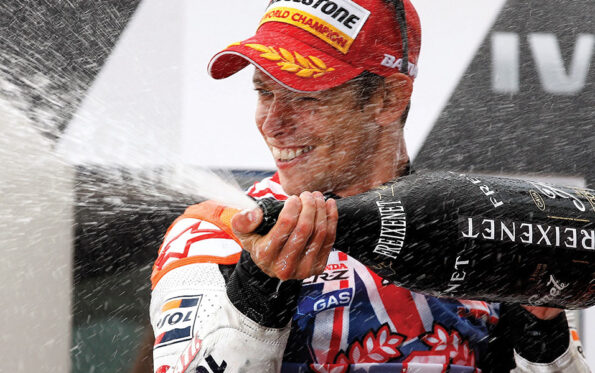
In an odd homecoming, his firstever road race in his home country was the 2001 Australian 125cc Grand Prix. Qualifying 19th, Casey was hemmed in by slower riders, his chase for the leaders halted. He finished an unhappy 12th for his first championship points. ‘Whenever I was heading into turn one, I could see the leaders exiting Southern Loop. I was running the same times as they were. If I had’ve been able to get past the slower guys earlier, I might’ve been up with them. I’m spewin’!’
All this garnered him a 250 GP seat for 2002, but trying too hard on an uncompetitive bike, he finished 12th. In 2003 he scored his first win on an Aprilia in the 125cc grand prix at Valencia, finishing the year eighth overall. He claimed the 2004 Malaysian 125 GP aboard a KTM to end the year fifth behind title winner Andrea Dovizioso and fourth-placed Jorge Lorenzo.
Stoner had knocked around the 125cc and 250cc championships until 2005 when he became a serious contender aboard an LCR Aprilia 250. His chief rival Dani Pedrosa piloted a factory Repsol Honda. Heading into Phillip Island, Stoner was coming off two victories in Malaysia and Qatar, his confidence sky high with talk of a possible move to MotoGP. Yamaha MotoGP rider, Texan Colin Edwards, went a step further. ‘If you ask me, Casey Stoner is a future MotoGP champion. The kid has got a determination and a will that does not stop.’
Gifted a big opportunity to edge closer to Pedrosa’s 250 championship lead after the Spaniard was seriously injured in practice, Casey crashed out early at Phillip Island. He finished the year runner-up followed by the announcement he would move up to MotoGP on an LCR-backed satellite Honda RC211V. After six years on the road Casey’s parents returned to Australia, their gifted 20-year-old son taking control of his destiny.
After arriving late to Qatar, Stoner grabbed an astonishing pole in just his second MotoGP to finish fifth. He backed it up with a narrow loss to Marco Melandri in Turkey. Wow. Casey turned more than a few heads and became someone to watch. But pushing too hard on Michelin’s B tyres, Casey experienced a number of high-speed get offs. The perception in the paddock was that Casey was proper fast but a crasher. He finished eighth in his first championship.
Ducati took a big risk signing him for 2007, but Stoner simply dominated on the Bridgestone-shod Duke from round one to card an incredible 11 victories. He clinched his first MotoGP title in Japan with three rounds to spare. In the Ducati garage, his parents hugged and jumped for joy. When his delirious crew hugged him, Casey could only bow his head and shake it in disbelief.
Piloting his first-ever factory bike, the all-new 800cc Ducati Desmosedici, Casey blitzed everybody including Valentino Rossi, who finished the season third behind Pedrosa. In the space of a season Casey Stoner had gone from crash-prone rookie to MotoGP’s fastest and most spectacular rider.
Halfway through 2008, Casey was timing his run perfectly to successfully defend his title with three consecutive victories to reel in championship leader Valentino Rossi. The cunning Italian and his crew chief Jeremy Burgess had other ideas. Rossi was able to halt Casey Stoner’s surge and dismantle the Australian’s bid to win backto-back MotoGP titles at Laguna Seca. After a pep talk from Burgess on the grid Rossi raised the stakes, engaging pole sitter Stoner with a series of very late moves including the famous block pass at the Corkscrew that saw Rossi contact Stoner. Rossi ran wide onto the dirt then cut back into the lead, technically illegal. Rossi’s aggressive moves threw the normally composed Stoner off balance. Casey misjudged his run into the sharp final turn while rushing up on Rossi. He ran wide and fell into a gravel trap, remounted and claimed a distant second. The momentum shift was seismic. Emotions ran high.
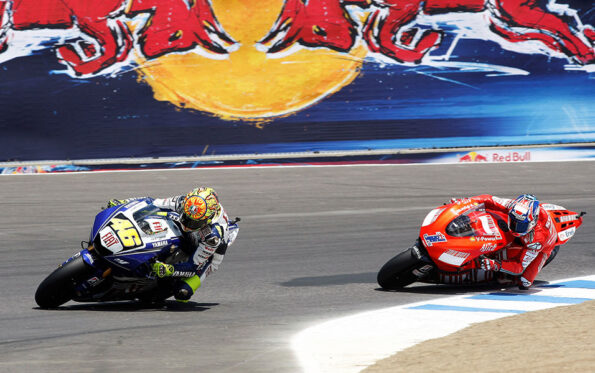
In parc fermé, Rossi rejoiced his most famous victory (there are more than 65 million YouTube viewings of the race). Celebrating excitedly with his team, Vale approached Stoner, who was being interviewed live on TV. Rossi put his hand out; Stoner refused to shake it. Rossi: ‘Great race.’ Stoner: ‘No, you can’t race this way.’ Rossi: ‘That’s racing, Casey.’ Stoner: ‘That’s racing? Okay, we’ll see.’
While some took pot shots at Rossi, Stoner also copped a minor backlash. Some top Aussie racers were surprised at his sensitivity to Rossi’s aggressive tactics. One said, ‘Casey would’ve grown up with that sort of thing in junior dirt track every day of the week.’ But there was a more recent precedent in Casey’s mind.
In the 2004 Dutch 125cc GP featuring Jorge Lorenzo, Roberto Locatelli, Stoner and Andrea Dovizioso, last-lap madness almost resulted in a number of high-speed collisions, the quartet crossing the line within 0.6 seconds. Casey told his dad, ‘If it’s gonna be like I don’t want to race anymore.’ The much-respected Randy Mamola was brought in to have a fatherly chat with the lads, not that it had any effect. Casey’s dad Colin said that even before Assen, the lads had been hauled in and given a calm-the-farm talk by Mamola. Stoner survived the 125 and 250 classes only to confront the ruthless Valentino Rossi.
The Stoner–Rossi rivalry was very bitter. Casey claims Rossi fans tried to wrench him and his then girlfriend and now wife Adriana from his pit scooter. ‘They’d also step out at you to try and make you crash,’ he said. ‘Valentino never put a stop to it. They’d write shit on the motorhome, made threats.’ Stoner also claimed the Italian and Spanish press twisted things he had said. On the track he broke his own rules of engagement by running Rossi wide since the Italian had done the same to him. ‘I showed him respect, he didn’t show any to me,’ Casey said. ‘I thought, “I’m gonna make your life hell.”’
At the Australian Grand Prix, Stoner was back to his best with a thumping six-second win over Rossi. In practice, Stoner was clearly a step up from the field in intensity and sheer speed. Powering out of turn one, his bike hit over 18,000 rpm, the V-four engine a pitch higher than his Ducati teammates. I later relayed my observations to veteran GP photographer Lou Martin. His reply? ‘Casey is up that thing for the rent just about everywhere, that’s why he’s so fast . . . and I don’t think enough is made about just how fast he is.’
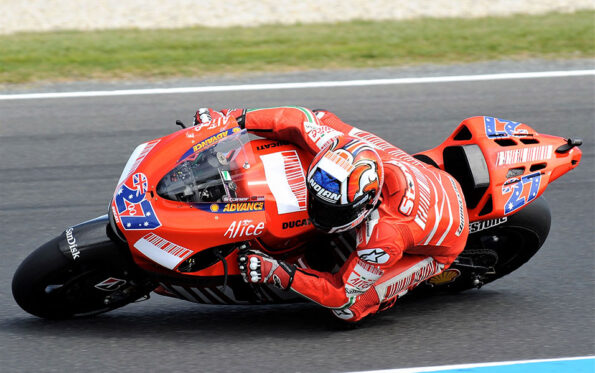
When second-fastest qualifier Jorge Lorenzo was later asked how he would approach the race while sat beside Casey in the presser, he said, ‘I think it will be okay . . . We’ll see [then gesturing to Casey with a resigned shrug and a sweep of his hand towards turn one]. Who knows, maybe he go crazy again, phffftt…’ Casey, who sometimes sat with his capped head bowed while others spoke, broke into a wide grin.
Casey did disappear at Phillip Island but his big win couldn’t stave off the inevitable.
One of the paddock’s most astute observers declared Casey Stoner one of the fastest riders he had ever seen. Carlo Pernat signed Rossi to his first GP contract with Aprilia in 1996, and has managed That’s why he’s so fast . . . and I don’t think enough is made about just how fast he is. Casey Stoner · 155 a bevy of MotoGP riders. ‘Without a doubt Casey is the fastest rider I have seen over the last ten years, and that includes Valentino,’ Pernat said at the Island. Rossi nevertheless ran away with the championship with nine wins, 373 points to Stoner’s 280.
Casey Stoner and Jorge Lorenzo both had fractured relationships with Rossi, but for different reasons. Aside from having a common enemy, they had great respect for each other. They would soon become pawns in an infamous MotoGP power play. Despite winning the opening round at Qatar, redemption didn’t come Stoner’s way in 2009 made harder by the new-control Michelins. Experiencing unexplained tiredness, Casey skipped GPs at Brno, Indy and Misano as he sought answers. He was eventually diagnosed as being lactose intolerant. During his prolonged absence, Ducati had serious doubts about his return and reportedly offered Jorge Lorenzo double Casey’s money to replace him.
It was here that the marriage between Stoner and Ducati washed onto the rocks. Ducati began to make changes to the Desmosedici, rendering it less of a firecracker so other riders could actually ride it. Stoner was the only pilot who could push the firecracker to the limit with precision riding and warp-like intensity. In response, Ducati blunted the Desmosedici. Allied to a suspect front end fitted with the less-desired Michelins, it blunted Casey Stoner.
Wayne Gardner started making noises that Honda should look to sign Casey. Honda hadn’t won MotoGP since 2006. They didn’t race to finish second. A two-year deal was done. After four years with Ducati, Casey would appear in Repsol Honda colours.
After falling out with Yamaha, Rossi took Stoner’s seat at Ducati on a two-year deal along with his long-time crew chief Jeremy Burgess, who vowed to fix the troubled bike. Stoner dominated the 2011 championship for Honda with 10 victories. Rossi finished a lowly seventh without a race win. When an overzealous Rossi knocked Stoner off in a risky move at Jerez, Rossi chased him down immediately after the race to apologise. In accepting his mea culpa, Casey famously told Rossi, ‘Obviously your ambition outweighed your talent.’ The Italian later admitted Stoner had done an amazing job at Ducati. ‘When I looked back at his telemetry, I wondered how he achieved such times.’
With the introduction of a production-skewed subclass claiming rule team (CRT), Casey was pretty much over MotoGP racing by 2012. He was only 26, but had been racing for 20 years. He was done. The press, social media, having his motorhome egged at the British Grand Prix, Ducati, Rossi, CRT . . . everything weighed on him. Despite his deep dissatisfactions he started 2012 strongly aboard his all-new 1000cc Honda. With speculation mounting, Stoner officially announced his retirement at round four in Le Mans. He won at Assen to draw level with Lorenzo in the championship after the Majorcan DNFed. Stoner won again in Laguna Seca and was looking good to take the title chase down to the wire. But a nasty crash during practice at Indy resulted in torn ankle ligaments, bringing his dream of a third world title to an end. He opted to race then had surgery, missing three rounds.
With his championship hopes gone, winning at Phillip Island for the sixth consecutive time was emotional for his many supporters. Flashing his toothy grin one last time atop the dais, Casey knew he was loved and respected by his country, and that was all that mattered. In a desperate bid to keep him, Honda offered Casey a staggering $15 million one-year deal, more than it had ever paid its Formula 1 drivers. He declined. A decade later Stoner admitted he may’ve been silly to have turned it down.
A Supercars anorak, Stoner was drafted into Triple Eight Racing to drive Craig Lowndes’ 2011 car in the 2013 Dunlop Series. After debuting impressively at Adelaide, his progress stalled. In the lead-up to Townsville, Casey announced he was not ready for Bathurst and made himself unavailable to codrive in the Supercar endurance rounds. He also had yet to commit to the next season with Red Bull Pirtek racing. When Triple Eight team principal Roland Dane was asked about Casey’s pronouncements, he seemed genuinely flummoxed. Casey left Supercars at the end of the year.
Stoner signed with Honda as a test rider in 2015, and put himself forward to replace the injured Dani Pedrosa early in the season. Honda boss Shuhei Nakamoto was torn over Casey’s offer and ultimately declined, saying a lack of prep may’ve resulted in one of Honda’s great legends circulating in fifth. Casey said he wouldn’t have been riding for the win anyway. Long after his retirement Stoner revealed he enjoyed qualifying more than racing because of the intense pressure he placed on himself to win. He said he was scared he would crash on every corner while chasing pole position.
When Stoner contested the 2015 Suzuka 8-Hour, he was well prepared: ‘I trained my arse off.’ His team was leading the race when not long into Casey’s stint, the throttle on his Honda stuck as he peeled into a fast right hander. It was a big crash, Stoner breaking his right scapula and left tibia in his last-ever race. After receiving an apology from Honda, he returned to Ducati as a MotoGP test rider in 2016.
By emphatically out-pointing Valentino Rossi over seven seasons of MotoGP, Casey Stoner is arguably Australia’s most significant Immortal. Mick Doohan no less says Casey will go down as one of the greatest riders in world championship history. His incredible skills, fierce intelligence and adamant quest for perfection will stand as Casey Stoner’s most exceptional qualities.
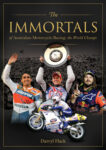
ABOUT THE AUTHOR
Darryl Flack has worked as editor at Australian Motorcycle News, was the Australian correspondent for MotoGP.com and freelanced for Two Wheels, REVS, Cycle Torque, Britain’s Motor Cycle News and US weekly Cycle News. He’s also interviewed the great racers of the world, track tested the latest models at Phillip Island, Sydney Motor Sport Park and Amaroo Park and dabbled in road racing, enduro and trials competition.
This is an edited extract from The Immortals of Motorcycle Racing: The World Champs by Darryl Flack (Gelding Street Press, $39.99rrp) available at Big W and all good bookstores
By DARRYL FLACK
For the full article grab the October 2023 issue of MAXIM Australia from newsagents and convenience locations. Subscribe here.




